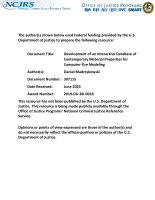Showing Results For:
Subtopic: Evidence analysis and processing
Analysis of Automotive Paint Smears Using Attenuated Total Reflection Infrared Microscopy
Date Published
2023
Journal
Applied Spectroscopy
Agencies
NIJ-Sponsored
Chemical identification and optimization of the 4-aminophenol colorimetric test for the differentiation between hemp-type and marijuana-type cannabis plant samples
Date Published
2023
Journal
Journal of Forensic Sciences
Agencies
NIJ-Sponsored
Use of Nanoparticle Decorated Surface-Enhanced Raman Scattering Active Sol-Gel Substrates for SALDI-MS Analysis
Date Published
2023
Journal
Journal of the American Society for Mass Spectrometry
Agencies
NIJ-Sponsored
A Forensic Science Informational Video Can Help Mock Jurors Evaluate Forensic Expert Testimony
Date Published
2023
Journal
Criminal Justice and Behavior
Agencies
NIJ-Sponsored
Addressing uncertain assumptions in DNA evidence evaluation
Date Published
2023
Journal
Forensic Science International: Genetics
Agencies
NIJ-Sponsored
Sequence-based Allelic Variations and Frequencies for 22 Autosomal STR Loci in the Lebanese Population
Date Published
2023
Journal
Forensic Science International: Genetics
Agencies
NIJ-Sponsored
Perceptions of forensic scientists on statistical models, sequence data, and ethical implications for DNA evidence evaluations: A qualitative assessment
Date Published
2023
Journal
Forensic Science International: Synergy
Agencies
NIJ-Sponsored
Massively Parallel Sequencing of the Mitogenome from Human Hair Shafts in Forensic Investigations
Date Published
2023
Agencies
NIJ-Sponsored
Role of Race/Ethnicity, Sex, and Age in Surface-Enhanced Raman Spectroscopy- and Infrared Spectroscopy-Based Analysis of Artificial Colorants on Hair
Date Published
2023
Journal
Acs Omega
Agencies
NIJ-Sponsored
Molecular genetic characterization of sudden deaths due to thoracic aortic dissection or rupture
Date Published
2023
Journal
Cardiovascular Pathology
Agencies
NIJ-Sponsored
Identifying reliable ions for the statistical differentiation of structurally similar fentanyl analogs
Date Published
2023
Journal
Journal of Forensic Sciences:
Agencies
NIJ-Sponsored
Using Exonucleases for Aptamer Characterization, Engineering, and Sensing
Date Published
2023
Journal
Accounts of Chemical Research
Agencies
NIJ-Sponsored
Detection, chemical analysis, and pharmacological characterization of dipyanone and other new synthetic opioids related to prescription drugs
Date Published
2023
Journal
Analytical and Bioanalytical Chemistry
Agencies
NIJ-Sponsored
NPS Discovery Q2 2023 Trend Reports
Date Published
2023
Agencies
NIJ-Sponsored
New Potent Synthetic Opioid—N-Desethyl Isotonitazene—Proliferating Among Recreational Drug Supply in USA
Date Published
2023
Agencies
NIJ-Sponsored
Expert Algorithm for Substance Identification (EASI) using Mass Spectrometry: Application to the Identification of Cocaine on Different Instruments using Binary Classification Models
Date Published
2023
Journal
Journal of Mass Spectrometry
Agencies
NIJ-Sponsored
The Impact of Vaping Ethanol-Containing Electronic Cigarette Liquids on Roadside Impairment Investigations
Date Published
2023
Journal
Journal of Analytical Toxicology
Agencies
NIJ-Sponsored
A Quantifiler™ Trio-based HRM Screening Assay for the Accurate Prediction of Single Source Versus Mixed Biological Samples
Date Published
2023
Journal
International Journal of Legal Medicine
Agencies
NIJ-Sponsored
A novel method for sorting and reassociating commingled human remains using deviation analysis
Date Published
2023
Journal
Journal of Forensic Sciences
Agencies
NIJ-Sponsored
Positivity of New Synthetic Cannabinoid 4F-MDMB-BICA Increasing in U.S. as Prevalence of 5F-MDMB-PICA Wanes
Date Published
2023
Agencies
NIJ-Sponsored
Comparison of Novel Raman Techniques for Fiber Forensics
Date Published
2023
Journal
Optics
Agencies
NIJ-Sponsored
Flexible structured light system calibration method with all digital features
Date Published
2023
Journal
Optics Express
Agencies
NIJ-Sponsored
Exploring regional aspects of 3D facial variation within European individuals
Date Published
2023
Journal
Scientific Reports
Agencies
NIJ-Sponsored
A method to generate capture baits for targeted sequencing
Date Published
2023
Journal
Nucleic Acids Research
Agencies
NIJ-Sponsored
Development of an Interactive Database of Contemporary Material Properties for Computer Fire Modeling
Date Published
2023
Agencies
NIJ-Sponsored
Research Forensic Library
We invite you to also search the Research Forensic Library, a curated collection of publicly-accessible material relating to every discipline of the forensic sciences.



